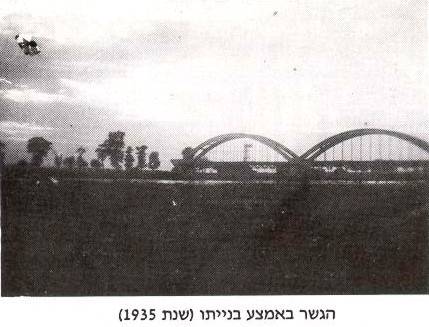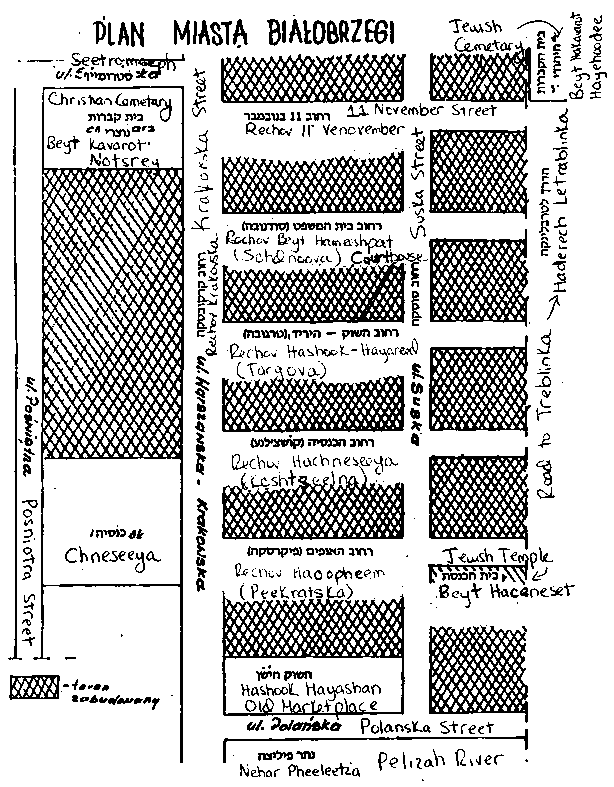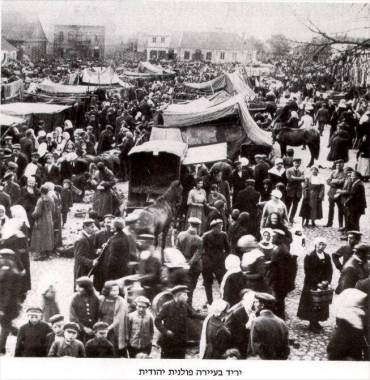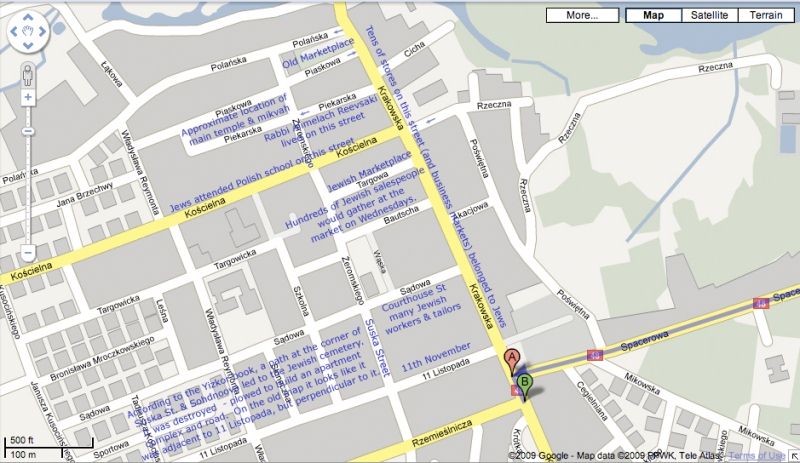
Bridge in the middle of being built in 1935.
|
[Page 7]
Sarah's comments are in
blue.
After the transliterated spelling of a town, (M) means the spelling
came from MapQuest, (B) means it came from a Polish map at the end of the Yizkor
book, and ? means that I could not find it anywhere.
Between the city of Warsaw and the city of Krakow, along 300 km, the person who wants to travel from Warsaw to the direction of Krakow begins traveling to the southern direction. He passes the cities Pruszkow(M), Grodzeensak(?) ?Grodzisk Maz., Piaseczno(M), Nadarzyn(M), and others. One finds right and left of the road, about 20 km from Warsaw, that you may happen upon the city of Tarczyn(B), that rests on the road.
Tarczyn(B), a town of Jewish ?, in the past had almost all of its people as Jewish.
When you continue on the road to Krakow, we notice on the left side of the street a sign that indicates the famous city of Gora Kalwaria(M) is not far from here.
Further down the road is the town of Grojec(M), the large town, Aseeseet(?), which served as a center place in business for all of the surrounding cities. Many Chasidic Jews lived there and this was, like we mentioned, a central place for all activities and different things.
Further down the road, on the left side of the road, another sign tells us about the town of Warka(M) that is found there. From this town, the Warka(M) rebbis spread the lite of torah and holiness to distant places.
In the town of Bialobrzeg, there was a center of torah and Chasidism, and many were Chasids of Warka(M).
From here, it is already not far to travel. We pass by more signs that tell us of the cities Gosheen(?) and Mogielnica (B), which lie on the left side of the road. We arrive at a valley named Falnatseeyatsa(?).
This valley is found approximately 72 km from Warsaw and is the entrance to Bialobrzeg.
On the sides of the valley, there are scattered small towns. In them, live the families of farmers. In them also were many Jewish families. Amongst villages, there is also the village Veekov(?) and more.

Bridge in the middle of being built in 1935.
At the southern exit from the city, we bump into a sign that tells us Radom(M) 32 km, Krakow 225 km, and others.
In the town of Bialobrzeg, the Jewish population was large when compared to the total population. In the counting of the dwellers in the year 1827 there were 785 families of which 323 were Jewish families (41.1%).
In 1857, there were 853 families of which 436 were Jewish families (51.1%).
In 1921 (and also 1935) the town grew to 2419 families of which 1418 were Jewish families (58.6%).
Just before the Holocaust, between 1920 and 1940, 60% of the town was Jewish. Therefore, the Jews had a big impact on the way things were done in the town. Their general influence and money were very decisive and this idea was apparent in relation to the heads of the Jewish congregation from the viewpoint of the Polish leaders and laymen.
When you come into the town, you arrive at a central street Krakovska, along which there are tens of stores and business markets belonging to Jews.
On the right side, there is a Jewish market, which is well known amongst Polish Jews. Hundreds of salespeople would stand once a week on Wednesday with merchandise. They decided about all the important matters - about selling things for the town.
The next street is the street Pheekraska (Street Haoopheem) on which the rabbi of the city, the great sage, the rabbi Alimelach Reevsaki, his memory of righteousness should be a blessing for us, lived in his time.
Further down the street on the right side there was the street Suska. On the corner of that street was the main temple of the town. In the courtyard there was also a Mikva.

Map of the Pre-WWII Town of Bialobrzegi
The next street is Kooshseelna (the Hachnseeya street). There was a Polish school where Jewish boys also learned. In the beginer 1st and 2nd classes, the Jewish boys learned only with Jewish teachers. In the classes afterward, from 3rd grade on up, the Jewish students learned together with Polish students.
This street brings us further to the city of Veeshmaz'seah, a close 10 km from Bialobrzeg.

The Jewish Market
The next street is called Targohva Street (the Marketplace Street of the Jews).
The next street is called Sohndoova Street (the street of the courthouse), where the courthouse is, is the street on which many Jewish workers, tailors and the likes lived.
The next street is 11 Vnohbnebar Street.
On Suska Street, that was parallel to the first street Krakovska, there was a store of horses (Yiddish name Dye Phartatz Me'erek). This street and the square on it is remembered for a very bad thing by the people who left that city in the time of the war. The Nazis (that there name should be erased) gathered the people of the city there before they took them to Treblinka. By using machine guns, they killed tens of the people of the town.
At the corner of Suska Street and Sohdnoova, there was a path that led to the Jewish cemetery.
NonJews lived outside of these streets in the rest of the town. The Jews mostly lived in the places that we spoke of.

Old and New Map - Information from the Pre-WWII map and the Yizkor book
preface “walking tour” of Jewish Bialobrzegi is combined with a modern map
They enacted educational foundations in the town. Torah and kindness were very great, and they taught about every kind of job.
Aside from the main temple in our town, there were also little shuls of Chasidm of Goon, Casidm of Varka, and Casidm of Rabbi Shraga Yaeer from Bialobrzeg. Also, there were many other minyans of groups of different kinds of jobs (ie the tailor's minyan), and there were also minyans in individual houses. For example, there was a separate minyan in the house of the head of the town, Reb David Cohen.
There were also many foundations for young people to teach them jobs. For example, from the group of young Jews, at the head stood a capable boy by the name of Me'er Goldberg. At the group, Nasan Lieberman and Me'er Cohen stood at the head. There were also groups of Boned, Mizrachi, Veytar and the group of Longwood. There were also groups formed by the government of Poland, which were sent out to different camps of learning like at Arzeh and etc.
The organization of these groups brought together and produced many events and close friendships.
Chaim Simcha Goldberg went to Israel through Sartpick, on a public relations trip. He went thru the group Agoodat Yisrael in Poland. After the success of this trip, other young people such as Meyer Kohn also went to Israel.
We remember the high holidays, Purim and Simchat Torah, as happy, pure and simple for the Jews of the city.
In the city, there was also an organization of kindness and help for the public. People performed acts of kindness and helpfulness and also had a charity fund.
When we remember the town before the holocaust, we remember how on every Thursday the city seemed festive because of the preparation for the Shabbat. On Friday, these preparations came to a climax when the rabbi Reevsky and after the rabbi Belomnaphled went to the markets to remind them to close for the Shabbat.
On Saturday and holidays you could almost feel the Chasidic holy atmosphere in the streets, as the town was adorned with grace.
Most of the people wore festive and Shabbat clothes. Everyone was wearing these clothes - butchers, teachers, workers, water carriers, cow herders, shoe makers and others all wore festive clothes on Shabbat. They danced and stepped with holiday spirit to the shul and to the shteebles (small shuls). It is impossible to compare the way they looked on Shabbat with the way that they looked during the week.
On Shabbat, they were completely different people. The holiness was spread over them and the divine presence was resting upon them.
Who could forget the song that the musicians sang. Yosel the water carrier sang in the third meal in the shul. He sang the songs that where the driving force of the whole 3rd meal. He poured out his soul and he wasn't the only one. Regular workers who appeared as simple Jews in the middle of the week came on Shabbat and on the holidays to reveal what they had inside them. They revealed Jewishness that burned like a fiery flame with a great desire for Hashem. Nothing in the world mattered to them except for holiness and goodness.
There were Jews in the town that people said knew the whole talmud, but didn't take part in Halochek issues which they left to the head rabbi of the town, the rabbi Rayske of blessed memory. Rabbi Rayske was known to be a great rabbi of the torah and was accepted and loved by all the people of the town. Afterwards, his young son in law, the rabbi Bloomenfeld, of blessed memory, was a well known student of the Rebi of Bet Aosrooav, of blessed memory, who was also a very learned person. He had great knowledge in worldly things and he had a great aura - he could bring out kindness and grace from all that would see him. He would give forth torah to the public with public torah classes. He had a great many students, including Rabbi Yosef Pratz Poyzer, who was a top notch talmud torah sage.
The head of the congregation was David Cohen, who was a great figure himself. You will see more about him in the chapter about the Cohen family.
Reb David sanctified himself through the community service and everyone knew that one could receive what they wanted - whether it was a communal or personal request.
The Israeli spirit of groups was conveyed to young Bialobrzegers who were filled with love for the land of Israel.
After Meyer Cohn went to Israel in 1932, he began to work in Namal, it should be built up. He sent a telegram to Moshe Sene after visiting the land of Israel. In a Warsaw newspaper, he wrote it under a headline that the people of Bialobrzeg were building up the land of Israel.
In the year 1933,... the text goes on from here (page 23), but it has not been translated yet.
|
JewishGen, Inc. makes no representations regarding the accuracy of
the translation. The reader may wish to refer to the original material
for verification.
JewishGen is not responsible for inaccuracies or omissions in the original work and cannot rewrite or edit the text to correct inaccuracies and/or omissions.
Our mission is to produce a translation of the original work and we cannot verify the accuracy of statements or alter facts cited.
 Bialobrzegi, Poland
Bialobrzegi, Poland
 Yizkor Book Project
Yizkor Book Project
 JewishGen Home Page
JewishGen Home Page
Copyright © 1999-2026 by JewishGen, Inc.
Updated 27 Jul 2009 by LA